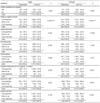Abstract
The purpose of this study was to compare eating habits and food attitudes between depressed and normal adults. The subjects were selected (n = 6217) from those who participated in the 2008 Korean National Health and Nutrition Examination Survey (KNHANES IV). The subjects were divided into the depressed (DG, n = 841) and normal groups (NG, n = 3969). DG was those who have depression now or who have experienced depressing feelings more than two weeks or per year. The general characteristics, anthropometric measurement, eating habits, the dietary guideline recognition and practices were compared by using chi-square test and t-test. Also the partial correlations were analyzed by SAS (Statistical analysis system, version 9.1) program. There was a significantly higher rate of DG among the female (74.32%), with low education (44.6%) and low-income (32.0%) subjects (p < 0.001). DG showed significantly lower snacking and dining out. There was significantly higher rate of DG who responded "none" in frequency of snack (27.10%) and dining out (29.50%) (p < 0.001). Also DG showed significantly lower rate of the subjects who ate with the family than NG. Also, DG showed significantly lower dietary guideline recognition level and practice than NG. Correlation between depression symptom and various factors showed that positive correlation with low snack intake and dining out frequencies. However, correlation was relatively weak. In conclusion, eating habits and recognition levels and practice of dietary guidelines of DG were significantly different from NG. DG showed significantly lower frequencies of snack, dining out, and eating with family.
Figures and Tables
References
1. Smith AP. Breakfast and mental health. Int J Food Sci Nutr. 1998. 49(5):397–402.
2. An YM. A study on the comparison of nutrient intakes and the mental health of girl students between day and evening session of commercial high school and academic high school in Masan. 1989. Kyung nam University;37–38. MS thesis.
3. Cheon SH. A study on eating behavior, depression, anger, anger expression and BAS/BIS in adolescent woman. Korean J Women Health Nurs. 2007. 13(4):310–319.
4. Cho SS, Jung SH, Choi S, Sung NJ, Park KH. The relationship between depressive tendency somatic symptoms and drug use in housewives. J Korean Acad Fam Med. 1997. 18(5):490–500.
5. Chung HK, Kim MH, Woo NRY. The effect of life stress on eating habit of university students in Chungcheongnam-do province. Korean J Food Cult. 2007. 22(2):176–184.
6. Devaud C. Eating disorders among female adolescents in Switzerland : prevalence and associations with mental and behavioral disorders. Int J Eat Disord. 1998. 24(2):207–216.
7. Dubow EF, Kauch DF, Blum MC, Reed J, Bush E. Correlates of suicidal ideation and attempts in a community sample of junior and high school students. J Clin Child Psychol. 1989. 18(2):158–166.
8. Fava M, Rappe SM, West J, Herzog DB. Anger attacks in eating disorders. Psychiatry Res. 1995. 56(3):205–212.
9. Han MH, Kim KJ. Consumption value and eating out behavior of male and female undergraduate students. Consumer Policy Educ Rev. 2008. 4(3):105–118.
10. Hong SM, Choi SY. A study on meal management and nutrient intake of the elderly. J Korean Soc Food Sci Nutr. 1996. 25(6):1055–1061.
11. Kang HC. Binge eating in obesity. J Korean Soc Study Obes. 2000. 9(3):45–54.
12. Kim JH, Lee MJ, Moon SJ, Shin SC, Kim MK. Ecological analysis of food behavior and life : styles affecting the prevalence of depression in Korea. Korean J Nutr. 1993. 25(9):1129–1137.
13. Kimmel PL, Weihs K, Peterson RA. Survival in hemodialysis patients: the role of depression. J Am Soc Nephrol. 1993. 4(1):12–27.
14. Lee BY. Psychiatry dictionary. 1997. Seoul: Ilchokak;305.
15. Lee EY, Cho MS. Effects of mood on the food preference of female university students. Korean J Food Cult. 2008. 23(6):713–719.
16. Lee SH, Suh JH. Korean public's ability to recognize depressive symptoms and beliefs on helpfulness of various methods. Ment Health Soc Work. 2009. 41–77.
17. Linde K, Ramirez G, Mulrow CD, Pauls A, Weidenhammer W, Melchart D. St John's wort for depression-an overviewand meta-analysus of randomised clinical trials. BMJ. 1996. 313:253–258.
18. Ministry of Health and Welfare. Korea Health Industry Development Institute. Revision of Dietary Guidelines for Koreans. 2008.
19. Ministry of Health and Welfare. Korea Centers for Disease Control and Prevention. 2008 Korean national health and nutrition examination survey (KNHANES). 2008.
20. Macht M, Mueller J. Immediate effects of chocolate on experimentally induced mood states. Appetite. 2007. 49(3):667–674.
21. Park JE, Kim SJ, Choue RW. Study on stress, depression, binge eating, and food behavior of high school girls based on their BMI. Korean J Community Nutr. 2009. 14(2):175–181.
22. Peveler R, Carson A, Rodin G. ABC of psychological medicine : Depression in medical patients. BMJ. 2002. 325:149–152.
23. Shaffer D, Pfeffer CR, Bernet W, Arnold V, Beitchman J, Benson RS, Bukstein O, Kinlan J, McClellan J, Rue D, Shaw J, Kroeger K. Practice parameter for the assessment and treatment of children and adolescents with suicidal behavior. J Am Acad Child Adolesc Psychiatry. 2001. 40(7 Suppl):24S–51S.
24. Son SM, Park JK, Lee HS. Depression and dietary factors related to hyperlipidemia in urban living elderly female from low income group. Korean J Community Nutr. 2003. 8(6):938–950.
25. Suh KY. The phenomenological study on the complaints of depression in Korea. Korea Univ Med J. 1968. 5(1):491–501.
26. Sung SJ, Kwon SJ. Effect of eating with family or alone on the self-rated mental or physical health : the elementary school children in Daejeon area. Korean J Community Nutr. 2010. 15(2):206–226.
27. Torres SJ, Mccabe M, Nowson CA. Depression, nutritional risk and eating behaviour in older caregives. J Nutr Health Aging. 2010. 14(6):442–448.




 PDF
PDF ePub
ePub Citation
Citation Print
Print













 XML Download
XML Download